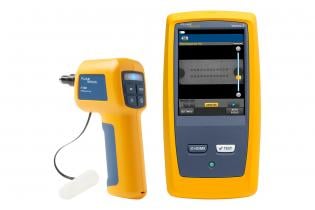Cutting-Edge OFDA Solutions for Precision Fibre Analysis and Testing
Cutting-Edge OFDA Solutions for Precision Fibre Analysis and Testing
Blog Article
Important Attributes to Try To Find in Optical Fiber Testing Tools
When examining optical fiber screening equipment, a number of necessary functions require cautious consideration to make certain optimum performance and dependability. Compatibility with existing industry criteria enhances functionality, while innovative measurement capabilities, including TDR and OTDR screening, offer crucial insights into network integrity. Comprehending these features will drop light on exactly how to choose the right devices for your particular requirements.
Precision and Accuracy
Accuracy and precision are important criteria in the analysis of optical fiber screening tools. These 2 characteristics make sure that measurements reflect real performance of fibre optic systems, which is important for reliable network installment, maintenance, and troubleshooting. Accuracy refers to the closeness of a gauged value to the real value, while precision denotes the repeatability of dimensions under the same problems.
When selecting optical fibre testing equipment, it is necessary to consider instruments that give high precision and precision to minimize mistakes in data interpretation. Gadgets such as optical time-domain reflectometers (OTDRs) and power meters need to have calibration mechanisms to make sure constant performance with time. Furthermore, the specs provided by producers should detail the equipment's measurement unpredictability, which straight impacts the dependability of test results.
Additionally, the performance of optical fibre screening tools can be affected by environmental aspects, such as temperature level and moisture. Picking tools made to alleviate these variables will improve dimension fidelity. To conclude, buying optical fibre testing tools with robust accuracy and precision features is fundamental for maintaining optimum network efficiency and making certain the stability of fibre optic interactions.

User-Friendly User Interface
The performance of optical fiber screening tools is not only figured out by its precision and accuracy; an user-friendly interface plays a significant function in boosting operational performance. A properly designed user interface simplifies the interaction in between the service technician and the tools, enabling an extra intuitive understanding of intricate features.
Secret attributes of a straightforward interface consist of clear navigation menus, logical formats, and conveniently accessible controls. These elements enable technicians to carry out examinations promptly without comprehensive training, reducing the chance of user error - ofda. Aesthetic signs such as progression bars, signals, and visual representations of data can significantly enhance the user experience by offering prompt responses on the testing process.
Furthermore, adjustable setups can even more improve procedures by enabling users to readjust specifications according to specific screening requirements. This versatility not just conserves time but additionally ensures that the tools satisfies varied application demands.
Integrating help attributes, such as tooltips and thorough guidebooks, right into the user interface can further equip customers, promoting self-sufficiency and self-confidence in running the tools. Inevitably, an user-friendly interface is from this source necessary for maximizing the capacity of optical fibre testing devices, causing a lot more reliable and effective screening outcomes.
Mobility and Longevity
Portability and resilience are crucial qualities of optical fibre testing tools, guaranteeing that it can endure the roughness of various atmospheres while continuing to be fibre testing equipment very easy to transport. Technicians usually operate in diverse settings, from telecoms hubs to remote installations, making it imperative that screening tools are lightweight and portable (ofda). Equipment developed with mobility in mind generally features ergonomic manages and situations that help with simple and easy motion, therefore boosting operational effectiveness on-site
Resilience is similarly necessary, as optical fiber screening equipment is frequently subjected to extreme conditions, consisting of temperature fluctuations, moisture, and physical influences. Devices constructed with rugged products such as reinforced plastics or metal real estates are better matched for these environments, reducing the threat of damages throughout usage and transport. Furthermore, equipment with water and dust resistance ratings, such as IP ratings, makes sure reputable performance in challenging problems.
Compatibility With Requirements
Making sure compatibility with sector criteria is crucial for optical fibre testing devices, as it straight influences the reliability and validity of test results. Optical fibre networks go through stringent performance standards developed by various companies, including the Telecommunications Industry Organization (TIA) and the International Electrotechnical Commission (IEC) Examining equipment needs to adhere to these criteria to make certain that measurements correspond and similar across different systems and settings.
When selecting optical fiber screening tools, users ought to confirm that the gadget fulfills pertinent requirements relevant to their certain application, such as those pertaining to depletion, data transfer, and crosstalk. Equipment that is certified with well-known standards not only helps in achieving exact outcomes however additionally facilitates interoperability among devices from various makers.
Additionally, compatibility with requirements guarantees that the equipment can be used in regulative compliance situations, which is crucial for jobs in sectors such as telecommunications, aerospace, and military applications. Consequently, buying optical fiber screening devices that aligns with existing industry criteria is an essential facet of preserving quality control and achieving optimum network efficiency.
Advanced Dimension Capabilities
Advanced measurement capabilities are a specifying function of modern optical fibre testing equipment, allowing for comprehensive analysis of network performance. These capacities make certain view it now that service technicians can examine crucial specifications such as signal loss, diffusion, and bandwidth, which are crucial for maintaining optimum interaction effectiveness.
One key aspect is the ability to perform time-domain reflectometry (TDR) and optical time-domain reflectometry (OTDR) examinations. These techniques enable users to recognize mistakes, determine the size of fibers, and determine the location of defects with impressive accuracy - ofda. Additionally, innovative devices typically includes the capability to measure optical power levels, helping to assess the total wellness of the network and ensure conformity with the needed specs.
In addition, some testing devices supply innovative algorithms for real-time evaluation, allowing quicker medical diagnosis and troubleshooting. In verdict, spending in optical fiber screening equipment with advanced measurement capabilities is vital for making sure network integrity and performance in today's demanding telecoms landscape.
Verdict

Report this page